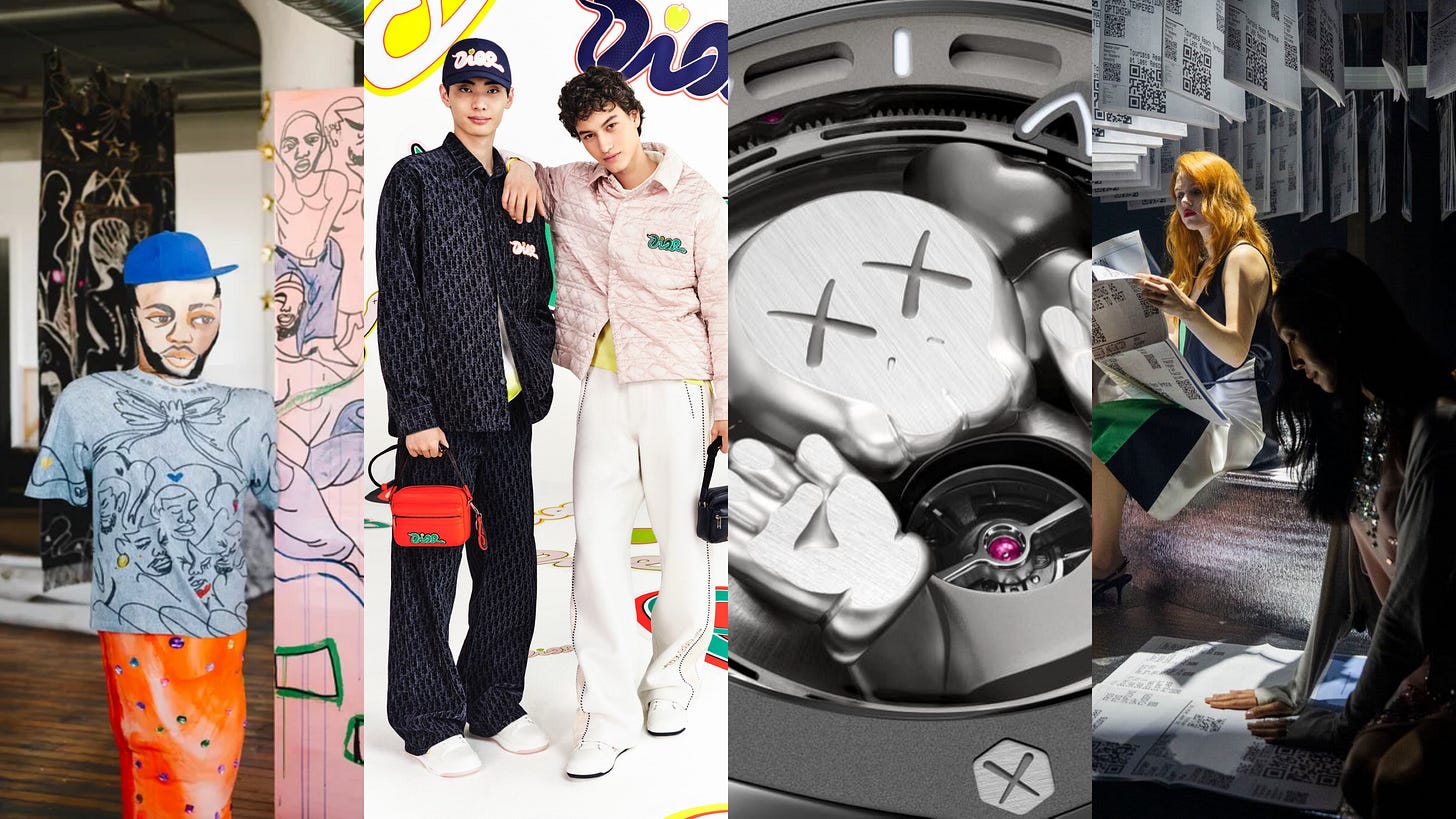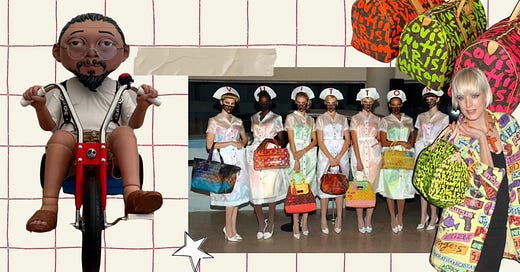The Fashion x Art Crossover
High fashion, higher meaning: fashion’s favorite muse is the art world
Art and fashion have long been co-conspirators, turning runways into retrospectives and collections into manifestos. Together, they blur the line between gallery and boutique, as style becomes solidified cultural capital.
Once upon a runway, fashion flirted with the art world. And then it married it, moved into a loft in SoHo, and now co-hosts VIP brunches during Frieze Week. From Yves Saint Laurent’s 1965 Mondrian dresses to Louis Vuitton’s graffiti-coated bags courtesy of Stephen Sprouse and Richard Prince, the alliance between these two creative titans has been less of a fling and more of a lifelong situationship.
This cultural co-dependency dates back nearly a century. Elsa Schiaparelli and Salvador Dalí’s Lobster Dress (1937) was less about dinner and more about Dada, proving that surrealist-inspired art can become couture. The dress was cheeky, quaint, and memorable. And ever since, the line between the gallery wall and the runway has blurred.
Fast forward to today, and the crossover has moved from eccentric to essential. No longer a creative indulgence or niche experiment, the art-fashion fusion is an aesthetic flex, a cultural passport, and a commercial goldmine. If a luxury label isn’t embedding itself in art, it's safe to assume it’s either rebranding, bankrupt, or trapped in a perpetual identity crisis.
In 2025, it’s no longer enough to make clothes; you must also make meaning. And so, the modern fashion house curates. It collaborates. It commissions. It releases capsule collections with the gravitas of a museum retrospective and unveils store windows that are like installations. Fashion doesn’t just wear art — it becomes it, at a speed that would make even a seasoned gallerist dizzy.
What began as mutual admiration has evolved into co-dependence, co-branding, and the holy grail of contemporary cool: co-authorship. The runway is now a conceptual space; the gallery is now a shoppable experience. And the message is clear: art may feed the soul, but fashion makes it look good in a selfie.
The Rise of Highbrow Hype
Marc Jacobs understands the assignment. His early 2000s Vuitton tenure turned collaboration into commerce, transforming the brand’s sacred monogram into a playground for contemporary artists. And just when fashion thought it couldn’t get more meta, enter Takashi Murakami, who not only splashed his candy-colored Superflat universe across Vuitton bags but also managed to become an institution in both spheres.
Today, the fashion-art collab has matured from novelty to necessity. Case in point: Murakami’s “Mononoke Made” capsule with Readymade, a marriage of anime, sustainability, and merch-ified conceptualism, debuted at Paris Men’s Fashion Week. The crossover is no longer a gimmick; it’s the strategy. The artist is no longer a guest star; they’re now a co-creative director, a brand muse, and a focal point.
This isn’t just about aesthetic synergy, though; it’s about building a branded ideology. Fashion art collaborations now function as miniature think pieces, articulating a label’s values. The message is clear: fashion wants meaning, and art offers it in digestible, Instagrammable formats.

Culture As Currency
In the age of algorithmic taste, art and fashion are happy bedfellows. Take Chanel’s Arts & Culture magazine — a 250-page exercise in visual diplomacy, distributed in 20 cities and designed not just to showcase legacy, but to solidify relevance. It’s a glossy love letter from fashion to the art world. With a global rollout, it reads less like a collectable relic for the aesthetically devout and more akin to a high-end equivalent of a coffee-table flex.
Meanwhile, Miuccia Prada, high priestess of fashion intellectualism, is commissioning immersive feminist performance art with Miu Miu’s Tales & Tellers, staged in repurposed warehouses with enough actors to rival a Broadway production. This isn’t just storytelling, it’s world-building. What looks like art is strategy, and what sounds like cultural commentary is brand finesse.
Brands aren’t just selling clothes; they’re selling a worldview. A limited-edition artist collaboration is no longer just a drop — it’s an alignment, a vibe. If 20th-century fashion relied on muses, 21st-century fashion relies on multidisciplinary mood boards. Part intellectual, part emotional, entirely shoppable.
Welcome to the Museum of Commerce
Nowhere is the art and fashion union more brazen than during Art Basel. At Miami Beach, Pucci threw a carnivalesque fun fair, Off-White launched a golf capsule, meanwhile KAWS dropped a Dior collection and an Audemars Piguet watch. This is experiential monetisation dressed in the language of cultural engagement. The entire affair is about strategic proximity: be seen near a sculpture, preferably wearing a capsule collection that passes the vibe check.
At Art Basel Hong Kong 2025, Vuitton turned Murakami’s oeuvre into an immersive playground, demonstrating what happens when luxury meets hyperreality. It was a firework display of commerce masquerading as culture — or maybe culture masquerading as commerce. Honestly, who can tell anymore?
Increasingly, these events aren’t just about showcasing product; they’re about manufacturing aesthetic legitimacy. Suddenly, fashion brands are no longer just brands; they’re cultural producers. It’s a new age take on commercial soft power: influence through intimacy, luxury through osmosis.

The Mutual Transaction of Cool
Fashion gives art an audience and a revenue stream; art gives fashion intellectual validation and just enough ambiguity to justify its price tags. Fashion brings the crowd, the capital, and the “co-lab.” Art brings the gravitas, the theory, the niche insider status. Together, they form a codependent force that swings between haute and hustle, philosophy and photogenic flat lay.
Even auction houses are taking note. Sotheby’s now sponsors over 30 brands, from Omega to Celine, oscillating between auction, archive, and aspirational retail. Once the bastion of old-world collectors with quiet money and quieter wardrobes, Sotheby’s has gone full cultural commerce — complete with “buy now” buttons and pop-up boutiques in New York, Hong Kong, and Paris.
This isn’t a glitch in the matrix; it’s a new business model. Art is no longer a separate sphere from fashion; it’s a category in the luxury vertical, somewhere between fragrances and NFTs. And if it feels like the soul of both disciplines is up for auction, well, at least it may come with complimentary champagne.
Final Look: From Muse to Model
Ultimately, fashion and art’s cohabitation isn’t just a trend; it’s the architecture of modern luxury.
The two worlds have stopped merely referencing each other; they’re now actively co-producing, co-signing, and co-profiting. As brands like Acne Studios partner with artists such as Jonathan Lyndon Chase to explore themes of queerness and Black subjectivity through retail exhibitions, we’re reminded that fashion’s newest frontier isn’t seasonal — it’s ideological.
Art is no longer just fashion’s muse. It’s the collaborator, the co-founder, the brand partner, and the pop-up guest of honour. The result? A cultural economy that rewards those who can think like artists and sell like brands.
In the end, fashion may still be about the clothes, but the smartest brands know it’s also about the context. And in 2025, context comes wrapped in concept, priced in scarcity, and framed like a limited-edition Murakami print… preferably available in-store, online, and on display during Art Week.
Welcome to the art of fashion. No gallery pass required. Just bring your Amex.
If you're vibing with this newsletter, subscribe to get weekly doses of fashion goodness straight in your inbox. It’s worth it, I promise.
Want to get in touch?
Follow me on Instagram
Follow me on Twitter
Follow me on LinkedIn






Art is no longer just fashion’s muse. It’s the collaborator, the co-founder, the brand partner, and the pop-up guest of honour. The result? A cultural economy that rewards those who can think like artists and sell like brands.
#quotesuponquotes.🙌🏿